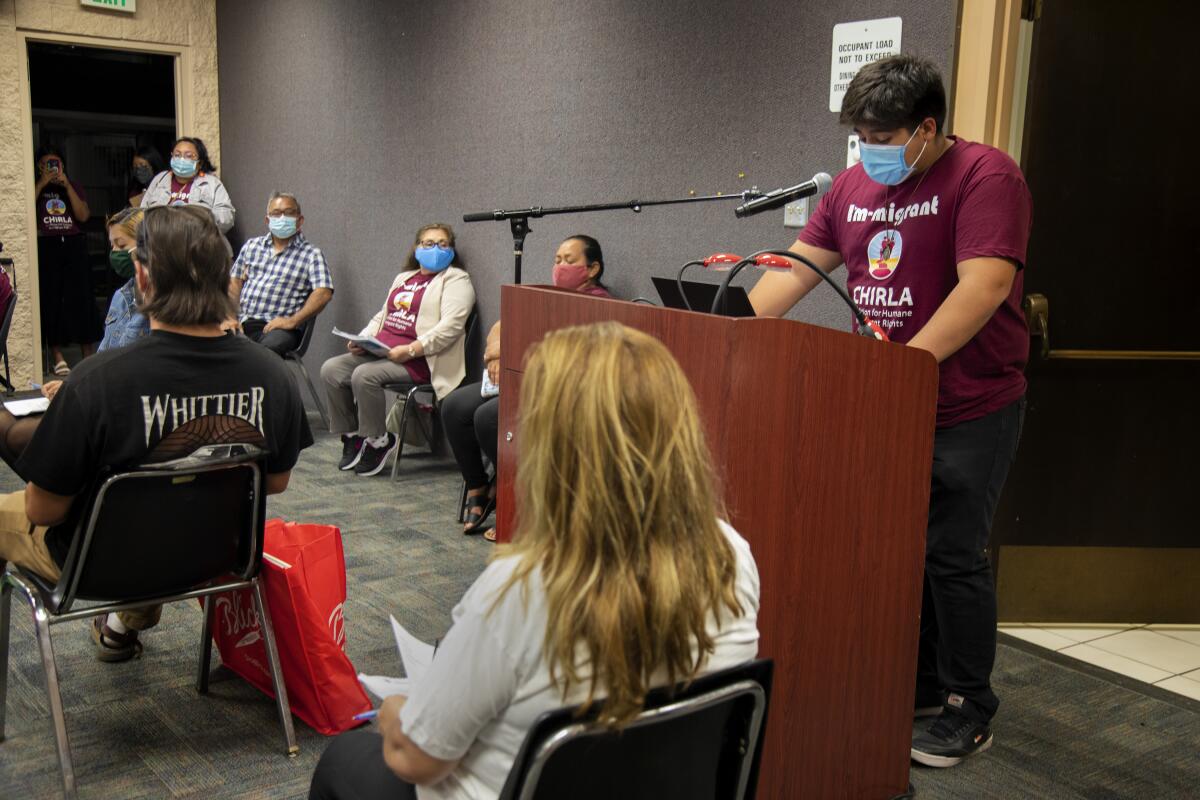Fair and independent redistricting? Los Angeles County does it already

- Share via
Los Angeles has been rocked by revelations that three city councilmembers used racist, anti-Black, anti-Indigenous, antisemitic, anti-LGBTQ comments and other vile language as they strategized on how to redraw the City Council districts to expand their political power. Such language and attitudes have no place in the political process and those involved now face the public’s justified anger.
This episode has also focused public attention on the redistricting process. Some city leaders are proposing that Los Angeles move to an independent redistricting process headed by citizens instead of politicians or political appointees. Fortunately, Los Angeles County’s Citizens Redistricting Commission shows how this can work and the benefits of an independent body.
Historically, the L.A. County Board of Supervisors — like the L.A. City Council — had power to draw redistricting maps every 10 years after each census. After many redistricting cycles in which the board was accused of protecting incumbents and disenfranchising minority voters, the state Legislature in 2016 passed Senate Bill 958 to require the county to carry out redistricting through an independent commission under specific statutory criteria. The county sued the state over the law, but it was upheld as constitutional and went into effect with the 2020-21 redistricting process.
Under the new county process, map drawing is conducted by citizen commissioners who are chosen without the influence of politicians. The commission must adhere to federal and state laws, and the drawing of districts is guided by statutory criteria and public input. It must do its work openly in scheduled public meetings at which anyone can provide information, criticism, suggestions for line drawing or proposed maps. Most importantly, the commission has the power to adopt a final map that cannot be rejected or modified by the Board of Supervisors.
The 14 members on the current commission were chosen from an initial pool of 741 applicants. The registrar-recorder/county clerk independently reviewed the applications and narrowed the pool to the 60 most qualified applicants based on specific criteria, such as ability to apply laws related to redistricting and voting rights, geographic diversity, and the ability to be impartial. Eight commissioners were chosen by lottery, with at least one residing in each of the five supervisorial districts. Those eight then reviewed the remaining 52 applicants and chose six more commissioners so that the body would reflect the demographics of the county.
The result is a commission with seven Democrats, three Republicans and four independents, which closely tracks the political party split in the county. We also reflect the racial and ethnic composition of county — with six Hispanic/Latinx, four white, two Asian Pacific Islander and two Black commissioners. The commission is nearly equally split between men and women, has LGBTQ members and has a wide range of ages.
Our objective was to draw five supervisorial districts that each had roughly the same number of people, complied with the Voting Rights Act, were reasonably compact, and kept together most cities, neighborhoods and other “communities of interest.”
Any decision we made required a supermajority vote of at least nine commissioners. That meant no one group could dominate and we had to seek consensus so that we could get the necessary number of votes on every issue.
A crucial factor was that all discussions and decisions were made openly, in public meetings scheduled in advance (in person or on Zoom), on topics previously announced in published agendas. We received thousands of comments from the public. The result was the antithesis of decisions being made in the proverbial backroom.
In this process, the commission was asked to consider the effect of drawing multiple majority-Latinx districts, of trying to put the San Fernando Valley in a single district, of dividing the northern part of the county into two or three districts running north-south instead of all being in one north county district, of dividing up economic/employment centers and cultural or recreational assets among the various districts, among many other issues. We considered all of it, guided by the law and informed by public input. This was democracy in action at the local level.
We ultimately reviewed more than 100 map options before finally adopting the official map that will govern L.A. County for the next decade.
There is no doubt that mandatory public participation slowed down the process, but it was certainly better than having incumbent politicians strategizing to stay in office or disadvantage their political enemies through redistricting tactics.
Of course, an independent redistricting commission will not cure all of L.A.’s ills. But would you rather have a diverse group of your fellow citizens, selected in an impartial process without ties to the current body, make redistricting decisions at an open meeting after taking input from all interested members of the public? Or would you rather have the current council revise district lines submitted by their handpicked representatives to fit their own needs? Or worse, have a small group of incumbent councilmembers scheme to carve up districts to favor their political allies, in secret, in a major lobbyist’s conference room?
Los Angeles has seen what politician-driven, backroom-dealing redistricting yields. It’s time to try a more transparent, democracy-promoting alternative.
Daniel M. Mayeda and Carolyn Rose Williams are co-chairs of the Los Angeles County Citizens Redistricting Commission. This article reflects their personal views, not the views of the commission.
More to Read
A cure for the common opinion
Get thought-provoking perspectives with our weekly newsletter.
You may occasionally receive promotional content from the Los Angeles Times.









